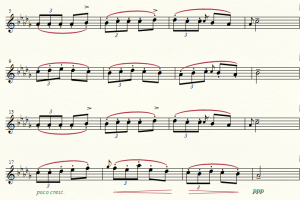I wrote this analysis and suggestions on interpretation for my friend. I enjoyed to think about how to play this small and popular piece on the stage.
Interpretation of Chabrier Habanera
This lovely piece just requires sweet sound and relaxed feelings when you play in the bar. But what if you play it in your important concert? You will try to study this piece seriously for your interpretation. 115 measures in slow tempo is not a short piece to understand at a glance, and it would be difficult to give an impressive performance on the stage if you are not well prepared.
First, let’s look at the theme shown below.
Character and features of the Theme

Since Habanera is not based on traditional dances, so there is not much to talk about except the unique and impressive rhythm of base. Chabrier made some features and rules in his theme. The theme is composed by two periods made by 2 phrases each, and has regular style of A-B-A-C.
Then, have a close look at the accents in phrase A.
it has a pattern of [ – – – X][ – – – X][ – – X -][ X – – – ]. Accent marks or ornaments or arpeggios come to the place of X.
There is no expression marks in phrase B. It means it should be played by natural quiet accents like [x – – – ][x – – – ][x – – – ][x – – – ]
In the second period, phrase A is the same as the first one, but C has poco cresc. cresc. mark < and decresc. Mark >, and it ends by ppp.
It is very important to keep the above expression unless other ones specified.
You may feel A has an advancing power, B is quiet, and C is climax. This theme appears 4 times changing their character each time. Play this theme until you get your clear image for this theme.
Then, we review the structure of the work and think about an interpretation.
Introduction;
There may be several ways to play this 4 measure length introduction. To emphasize the rhythm of Habanera at the first measure or, to keep the same rhythm just before the theme comes in. This really depends on your interpretation.
Theme (First time) (4-22)
The theme is presented quiet, but your interpretation on the theme shall be clearly shown with effective climax.
Theme (Second time) (23-36)
Theme is transposed by an octave upward. The object is to secure the theme. I do not recommend any ritardando between the first and the second because it may decrease the impact of next period. Here, arpeggios substitute accents.
A-flat, first beat of 36 measures, pp would be suitable, for it is after Sf>.
Passage (37-51)
In this part, the rhythm of Habanera is introduced by exaggerated rhythm with sf, f. Then, the rigid rhythm gradually relaxes and become triplets and connect to 6/8 portion which could be played freely with rubato.
It would be a good idea to keep rubato until measure 49, and return to regular rhythm from pp.
Theme (Third time) (62-68)
This portion is the climax of the work; it looks l the performance before this portion was just the preparation for this climax that is from measure 64 to 67. Then, it moves to connecting portion with lingering imaginary.
Connection Part (75-83)
Measures from 75 to 84 are spent for the connection to the 5th and final theme presentation. This part requires elaborate expression as shown below. But I think this part shall be played in tempo in principle. Many pianists do something here to express dolce, sf, <,> pp, but orchestra performance usually keep a tempo here. The phrase by g-as-as1-as1 is used 7 times here with gradual decrescendo. It may be one of the reasons
 .
.
Theme (Forth time) (84-99)
This part would correspond to the recapture of sonata form. First period [A-B] is ornamented by a beautiful counter melody, and 2nd period [A-C] is tutti by full orchestra.
Coda (100-115)
I like to play D-flat with a trill clearly because it indicates the start of Coda.
Analysis
|
Measures
|
Title
|
Description
|
|
1-4
|
Introductio
|
Rhythm of Habanera
|
|
4–22
|
Theme
|
|
|
23-36
|
Asureance of Theme
|
|
|
37-51
|
Passage
|
|
|
62-68
|
Theme
|
Climax
|
|
69-75
|
Expantion of theme
|
|
|
75-83
|
Connection part
|
|
|
84-99
|
Theme
|
Recapture
|
|
100-115
|
Coda
|
|
